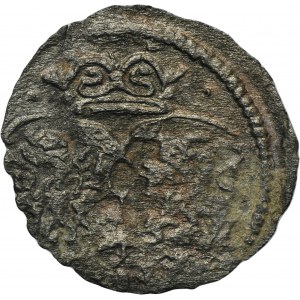A very rare denarius with the date 1620.
The background of the monetary history of the Commonwealth during the reign of Sigismund Vasa was the progressive monetary crisis caused by the situation in Germany and the influx of spodleniated German coinage into Poland. Initially, the mint rate was determined by Stefan Batory's ordinance of 1580. With the crisis deepening, in 1601 it was decided to raise the mint rate, i.e. devalue the denominations in circulation. The following years saw further legislation lowering the silver content of various denominations. Of these, the most important was the Ordinance of 1623. It introduced a stable monetary system, based on the monetary system of the Empire. During the reign of Sigismund III, new denominations appeared in the Polish-Lithuanian Commonwealth - three-cornered coins, halves and orts. On the other hand, in 1621, the highest denomination in the history of Polish money - the hundred-drachma - was minted at the Bydgoszcz mint. This was the crowning achievement of the intensive issuance of gold coins during the reign of Sigismund III. Crown mints (Olkusz, Wschowa, Poznań, Malbork, Bydgoszcz, Lublin, Kraków, Warsaw), Lithuanian mints (Vilnius), municipal mints (Gdańsk, Elbląg, Toruń, Riga, Poznań, Wschowa) and a private mint in Łobżenica worked during this period. Sigismund Vasa's Swedish coins were issued by mints in Stockholm, Rewal and Malbork. In 1627, a decision was made to stop issuing small coinage. This decision remained in effect until 1650.
Denars and their multiples belong to the group of the most diverse and at the same time the most mysterious coins of Sigismund Vasa. As Z. Żabiński wrote, there are no guidelines in the ordinances of the period regarding the minting rate of denars, dwudenars and ternars. The content of pure silver in denars can possibly be derived indirectly by recalculating data from the contract concluded by the city of Poznan with the administrator of the city mint, Beker. The calculation shows that a denarius at that time contained 0.026 grams of pure silver. On the other hand, in 1622-1624, referring to the standard of the shekel, it can be calculated that the denarius contained about 0.0136 g of pure bullion. Another mystery is the origin. E. Kopicki noted that the crown denarii and three-coins minted in 1616-1624 have no mint marks, hence it is difficult to assign them to a specific mint. At issue are the Cracow mint (most often cited in the literature and auction descriptions) and the Bydgoszcz mint. There are no problems with determining the origin in the case of Lithuanian coins, city coins and those from the private mint of the Krotoski family in Lobznica. The Lithuanian mint in Vilnius issued two-denarii and thirds, the municipal mint in Poznan issued denarii and thirds, the municipal mint in Wschowa issued denarii, while the private mint in Lobzhenica issued denarii and thirds.









